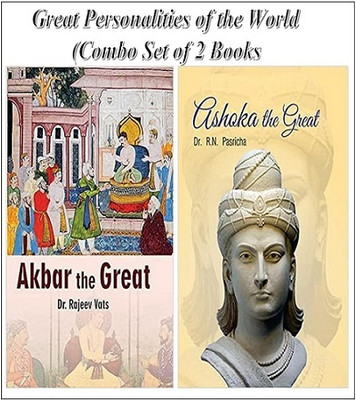Great Personalities Of The World: Akbar The Great & Ashoka The Great (Combo Set Of 2 Books)(Hardcover, Dr. Rajeev Vats & Dr. R. N. Pasricha)
Quick Overview
Product Price Comparison
Jalaluddin Mohammad Akbar (October 15, 1542 ŌĆō October 27, 1605) was the third Mughal Emperor of India. He was of Timurid descent; the son of Humayun, and the grandson of Babur who founded the dynasty. At the end of his reign in 1605 the Mughal empire covered most of Northern India. Akbar, widely considered the greatest of the Mughal emperors, was thirteen years old when he ascended the throne in Delhi, following the death of his father Humayun. During his reign, he eliminated military threats from the Pashtun descendants of Sher Shah Suri, and at the Second Battle of Panipat he defeated the Hindu king Hemu. It took him nearly two more decades to consolidate his power and bring parts of northern and central India into his realm. The emperor solidified his rule by pursuing diplomacy with the powerful Rajput caste, and by admitting Rajput princesses in his harem. The most momentous events of 1562 were AkbarŌĆÖs marriage to a Rajput princess, daughter of Raja Bharmal of Amber, and the conquest of Merta in Rajasthan. The marriage led to a firm alliance between the Mughals and the Rajputs. AkbarŌĆÖs empire supported vibrant intellectual and cultural life. The large imperial library included books in Hindi, Persian, Greek, Kashmiri, English, and Arabic, such as the Shahnameh, Bhagavata Purana and the Bible. Akbar regularly sponsored debates and dialogues among religious and intellectual figures with differing views, and he welcomed Jesuit missionaries from Goa to his court. Akbar directed the creation of the Hamzanama, an artistic masterpiece that included 1400 large paintings. This book places this subject in its most modern context as the foundation of this subject.Ashoka the Great (r. 268-232 BCE) was the third king of the Mauryan Empire (322-185 BCE) best known for his renunciation of war, development of the concept of dhamma (pious social conduct), and promotion of Buddhism as well as his effective reign of a nearly pan-Indian political entity. During Emperor AshokaŌĆÖs reign, India had a relatively well-managed government system. The reign of Emperor Ashoka is considered to be one of the most glorious periods in Indian history. During the first part of his reign, he worked systematically to consolidate and expand his empire. He ruled over the entire Indian subcontinent, except for the southernmost parts (i.e., Tamil Nadu and Kerala). During the later part of his reign, he is largely credited and admired for spreading the message of Buddhism and peace in many parts of the world. Although Buddhism faded in India after his death, it continued to flourish and spread in other parts of the world, primarily in East and Southeast Asia. The sufferings that the war inflicted on the defeated people moved him to such remorse that he renounced armed conquests. It was at this time that he came in touch with Buddhism and adopted it. Under its influence and prompted by his own dynamic temperament, he resolved to live according to, and preach, the dharma and to serve his subjects and all humanity. The book presents a plausible vision of the past balanced by captivating story. It is said that a great book if it is to endure cannot do without profound ideas.


